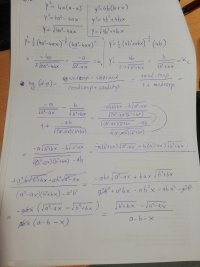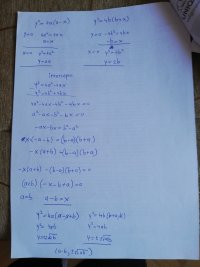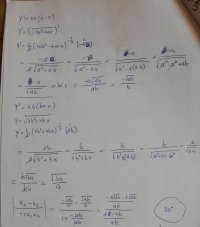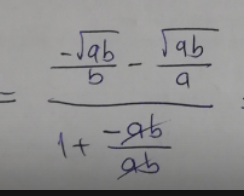Angle two curves
- Thread starter Loki123
- Start date
I am not sure I understand..If you swap 'x' and 'y' the angle won't change, but the derivatives will be easier to compute.
Can I just swap x and y like that???If you swap 'x' and 'y' the angle won't change, but the derivatives will be easier to compute.
Why?You might want to watch the sign of the angle though.
blamocur
Elite Member
- Joined
- Oct 30, 2021
- Messages
- 3,205
Maybe not. Nothing in the problem statement says that you need to compute a signed angle. Sometime the angle between two vectors is assigned positive values for counterclockwise direction from the first to the second and negative values for clockwise directions. This does not seem to be the case here, so please disregard my post.Why?
I meant, does switching x and y influence the sign?Maybe not. Nothing in the problem statement says that you need to compute a signed angle. Sometime the angle between two vectors is assigned positive values for counterclockwise direction from the first to the second and negative values for clockwise directions. This does not seem to be the case here, so please disregard my post.
BigBeachBanana
Senior Member
- Joined
- Nov 19, 2021
- Messages
- 2,277
You'll have to consider 2 cases:
1) Notice that for a=−b. Both curves are exactly the same. This is trivial.
2) For a=−b, the intersecting points are:
4a2−4ax=4b2+4bx(4a2−4b2)=(4a+4b)x2(2a+2b)(2a−2b)(2a+b)=xx=a−b⟹y2=4a(a−x)=4a(a−(a−b))=4ab⟹y=±2ab∴the intersecting points are {a−b,±2ab}
1) Notice that for a=−b. Both curves are exactly the same. This is trivial.
2) For a=−b, the intersecting points are:
4a2−4ax=4b2+4bx(4a2−4b2)=(4a+4b)x2(2a+2b)(2a−2b)(2a+b)=xx=a−b⟹y2=4a(a−x)=4a(a−(a−b))=4ab⟹y=±2ab∴the intersecting points are {a−b,±2ab}
Last edited:
blamocur
Elite Member
- Joined
- Oct 30, 2021
- Messages
- 3,205
Yes, reflections flip the sign of an angle. But I don't think the problem statement requires consideration of signs.I meant, does switching x and y influence the sign?
BigBeachBanana
Senior Member
- Joined
- Nov 19, 2021
- Messages
- 2,277
i am not sure i understand where this even came fromYou'll have to consider 2 cases:
1) Notice that for a=−b. Both curves are exactly the same. This is trivial.
2) For a=−b, the intersecting points are:
4a2−4ax=4b2+4bx(4a2−4b2)=(4a+4b)x2(2a+2b)(2a−2b)(2a+b)=xx=a−b⟹y2=4a(a−x)=4a(a−(a−b))=4ab⟹y=±2ab∴the intersecting points are {a−b,±2ab}
BigBeachBanana
Senior Member
- Joined
- Nov 19, 2021
- Messages
- 2,277
If you’re referring to the first line of case 2, maybe look at the question itself. It should look very familiar to you.?i am not sure i understand where this even came from
D
Deleted member 4993
Guest
dy/dx = tan(t) then dx/dy = cot(t) = tan(pi/2 - t)If you swap 'x' and 'y' the angle won't change, but the derivatives will be easier to compute.
If you draw two intersecting curves, the difference of the gradients of the tangents at the point of intersection will not change after reflection.
BigBeachBanana
Senior Member
- Joined
- Nov 19, 2021
- Messages
- 2,277
Isn't tan 90 degrees 1/0?
View attachment 32379
First, you're dividing by 0 here. How do you get 90? Something isn't right.
Second, you have two points of intercepts, therefore you should have 2 angles.
I never get two angles using the formula, only one.Isn't tan 90 degrees 1/0?
BigBeachBanana
Senior Member
- Joined
- Nov 19, 2021
- Messages
- 2,277
Yes, you're right. I was following your work and did not see tan(x) anywhere. I did it with implicit differentiation, the derivative is a bit cleaner IMO.Isn't tan 90 degrees 1/0?
y12=4a(a−x)2y⋅y1′=−4ay1′=y−2aSimilarly,
y22=4b(b+x)2y⋅y2′=4by2′=y2b
First point of intercept, (a−b,2ab)
y1′=y−2a=2ab−2a=ab−ay2′=y2b=2ab2b=abbtan(θ1)=1+ab−a⋅abbab−a−abb⟹θ1=90°For the second intercept, plug- in y=−2ab into the derivatives for the second angle.
Last edited:
How did you get the second line?y12=4a(a−x)2y⋅y1′=−4a




